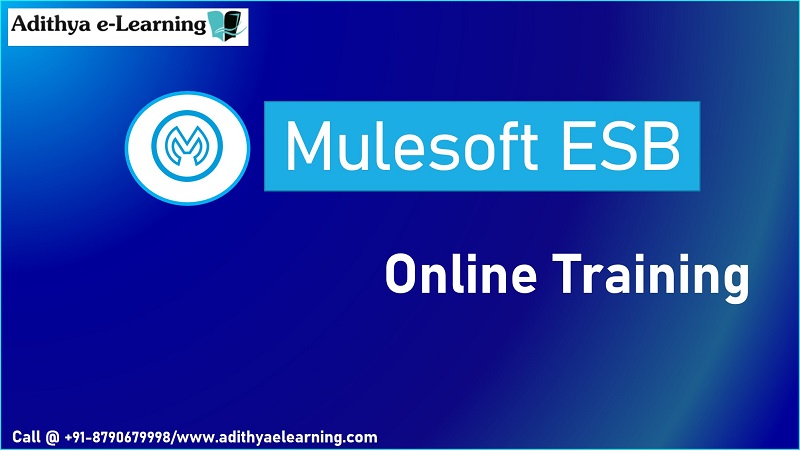Mulesoft ESB Online Training Course in Hyderabad, Telangana, India
Module 1: Introducing the Anypoint Platform
Describe the benefits of Any point Platform and MuleSoft’s approach to be successful with it
What is MuleSoft and ESB, and competitors to MuleSoft
Before and after ESB(mule soft) and How the mule soft operates
Advantages with MuleSoft
Mule any point platform and its components
Describe the purpose of each file and folder in a Mule project
Any point Studio to create Mule flows graphically
Describe the role of each component in building application networks
Logging message processors data
Read and write message properties
Build, run, and test a Mule application
Application local testing
Mulesoft ESB Online Training Course in Hyderabad, Telangana, India
Module 2: Structuring Mule Applications
Use flows, sub-flows, private flows, sync, and flow references
Specify application properties in a separate properties file and use them in the application
Encapsulate global elements in separate configuration files, mule domain project
Module 3: Basics
Create variables, payload, attributes
Define Mule properties and create properties files, along with types of properties files and
definition types
Read and write event properties
Write expressions with the DataWeave expression language
Log event data
Debug Mule applications
Module 4: Debugging and Troubleshooting Mule Applications
Use breakpoints to inspect a Mule event during runtime
Install missing Maven dependencies
Read and decipher Mule log error messages
Mulesoft ESB Online Training Course in Hyderabad, Telangana, India
Module 5: Writing DataWeave Transformations
Ways to write data weave scripts
Write DataWeave expressions for basic to extensive XML, JSON, flat file transformations
Write DataWeave transformations for complex data structures with repeated elements
Define and use global and local variables and functions
Read and write files using DataWeave scripts
Use DataWeave functions
Coerce and format strings, numbers, and dates
Call Mule flows from DataWeave expression
Module 6: Scopes
Configure and use batch processing
Use the Cache Scope to store and reuse frequently called data
Create and manage caching strategies
Use Enrichers to enhance a Mule message
send continuous messages until endpoint acknowledges
Module 7: Flow Control
Use splitters, aggregators, and multicast routers
Use the For-each scope
Module 8: Using Connectors
Using Http and Https connector to send and receive secure and non-secures and exposing
services over the internet
Retrieve data from a Database using the Database connector
Create parameterized SQL
queries for the Database connector
Retrieve data from a REST service using HTTP Request or a REST Connector
Use a Web Service Consumer connector to consume SOAP web services
Use the Transform Message component to pass arguments to a SOAP web service
List, read, and write local files using the File connector
List, read, and write remote files using the FTP connector
Use the JMS connector to publish and listen for JMS messages
Module 9: Routing Events
Use the Choice router to route events based on conditional logic
Use the Scatter-Gather router to multicast events
Validate data using the Validation module
Module 10: Controlling Event Flow
Multicast events
Route events based on conditions
Validate events
Module 11: Handling Errors
Handle messaging errors at the application, flow, and processor level
Handle different types of errors, including custom errors
Use different error scopes to either handle an error and continue execution of the
Parent flow or propagate an error to the parent flow
Set the success and error response settings for an HTTP Listener
Set reconnection strategies for system errors
Module 12: Triggering Flows
Read and write files
Trigger flows when files are added, created, or updated within the folder
Trigger flows when new records are added to a database table
Schedule flows to run at a certain time or frequency
Persist and share data inflows using the Object Store
Publish and consume JMS messages
Module 13: Processing Records
Process items in a collection using the For Each scope
Process records using the Batch Job scope
Use filtering and aggregation in a batch step
Module 14: Introducing Application Networks and API-Led Connectivity
Describe how to build an application network using API-led connectivity
Explain what web services and APIs are
Make calls to secure and unsecured APIs
Module 15: Building APIs
Use Anypoint Studio to build, run, and test Mule applications
Use a connector to connect to database
Use the graphical DataWeave editor to transform data
Create RESTful interfaces for applications from RAML files
Connect API interfaces to API implementations
Module 16: Consuming Web Services
Consume web services that have a connector in Anypoint Exchange, Consume RESTful web services
Consume SOAP web services
Pass parameters to SOAP web services using the Transform Message component
Transform data from multiple services to a canonical format
Module 17: Deploying and Managing APIs
Describe the options for deploying Mule applications
Module 18: Best Practices
Deploy Mule applications to Cloud Hub
Use API Manager to create and deploy API proxies
Use API Manager to restrict access to API proxies
Validate JSON files with Schema reference
Execute business logic on other programming languages like java
Be the first to leave a review.

